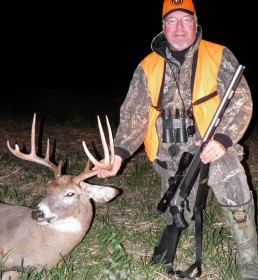Deer Hunting: A.M. or P.M.?
SHARE THIS POST
Whether you plan to hunt in the morning or evening, Mike Roux warns, don’t waste your hunts by going out at the wrong time.
Here some reasons I like morning hunts: I love watching the woods come alive as daylight sweeps over the land. That alone might be reason enough for me to hunt mornings, but there are more practical reasons to be in the stand at daylight. Bucks that have been out carousing all night are often caught off guard when the sunlight touches the treetops. They suddenly have a quickness to their step and they start to focus on heading back to secure bedding cover. Doing this in a bit of a rush causes them to take more risks than they might usually.
My best buck was taken in just such a scenario. I caught him sneaking back towards the thicket where he normally beds, but he could not resist stopping at a scrape I had just freshened with urine. The first two hours of daylight are peak movement times for bucks that are cruising for does during the rut. I am in the stand every morning I can be during November.
Hunting near bedding areas is great in the morning because it allows you to sneak into a treestand in the dark that you wouldn’t normally be able to get into while the deer are bedded. Some places simply allow you to get in position easier without being detected in the early morning.
I also like evening hunts. When on a bedding-to-feeding pattern, deer movement is often very predictable. This is especially true during the early part and the late part of the season, when their primary focus is food. Unlike the early mornings I mentioned when they sometimes trickle in over a few hours, their evening movements are often coordinated and very visible as they move down the trails all at once, heading to fill their empty bellies. More whitetails have probably been killed in the last hour of daylight for this very reason than at any other hour of the day or night.
Another obvious advantage to the evening hunt is the ease with which you can sneak into your stand location. If you are heading in during the daylight, you can often get yourself in position several hours in advance to allow your scent to dissipate somewhat.
Are you enjoying this post?
You can be among the first to get the latest info on where to go, what to use and how to use it!
There are, however, some potential problems with evening hunting. The number-one disadvantage is that you often have deer around you when nighttime settles in. Once you spook them getting out of the stand in the dark, your odds of shooting one from that stand significantly diminish. That is particularly true with mature bucks that have very good memories and do not take chances. You may not see that buck in that location for the remainder of the season.
Another disadvantage of hunting in the evening is that you will be tracking your deer in the dark, but after all, tracking a deer any time can hardly be considered a negative!
So, choose your hunts and your hunting time wisely. You have only a few times at each location to make it happen and each time you hunt a stand there are little things that cause that location to have slightly less effectiveness. Whether it’s the morning or evening, play each card carefully and don’t waste your hunts by going out at the wrong time.
For more helpful hunting insight, check out the fall issues of MidWest Outdoors, available the first full week of every month at the newsstand or by subscribing on our website.
MWO
SHARE THIS POST
You may also like...
Nothing found.
Did you enjoy this post?
You can be among the first to get the latest info on where to go, what to use and how to use it!
Mike Roux
Mike Roux is an award-winning outdoor writer. He is a former Illinois Outdoor Writer of the Year. Roux is also a renowned speaker available to sportsmen’s groups as well as youth and church groups. Check him out at mikeroux.com.
